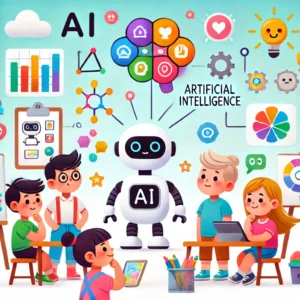
Artificial intelligence (AI) is increasingly present in our daily lives, from virtual assistants to video and game recommendations. However, explaining what artificial intelligence is to children can be a challenge. Here are some simple concepts and activities that can help parents and teachers to convey this fascinating technology in a way that is accessible to children.
1. Simple Explanation: "Learning Machines".
To begin with, it is useful to think of AI as "machines that learn." You can explain it like this:
"Imagine you have a computer that, instead of being programmed to do something specific, can learn by watching. It's like a robot watching how you do something, practicing and getting better at it every time it tries. That's how artificial intelligence works."
This type of analogy helps children visualize AI as a machine that improves and learns by doing.
2. Comparison with the Human Brain
Another way to explain AI is to compare it to the human brain. You can tell them that AI tries to do some of the things that humans do, such as recognize faces, understand words, and make decisions, but that, unlike us, machines do it in a very specific, data-driven way.
"Artificial intelligence learns using a lot of data, just as you learn from what you see and hear. For example, if you see lots of animals, you can learn to tell a dog from a cat. AI learns to do that too, but it needs to see lots and lots of examples to get it right."
3. AI Simulation Games
Games and hands-on activities are excellent for teaching AI. You can play games in which children act as a "machine" that learns. A popular game is "Guess the Object": select an object in the room, and children can ask yes or no questions to find out what it is. Then explain to them that, similarly, AI uses many questions or quizzes to learn and guess things.
4. Introduce the Data Concept
AI relies on data to learn, so a fun way to understand this is to talk about data as "hints" or "pieces of information" that help AI learn. You can tell them:
"Data are like clues that help artificial intelligence understand something. The more clues it has, the better it can learn. For example, if an AI sees pictures of many types of flowers, it can learn to distinguish them by seeing more details in each image."
5. Classification Activities to Understand "Training".
A fun activity is to create a collection of pictures or cards (e.g., with fruits and vegetables) and ask children to sort them into different categories. Explain to them that this is similar to what the AI does when it "trains" itself, as it needs to sort data in order to learn from it.
6. Beware of Expectations: AI Is Not Magic
It is important for children to understand that AI is not magic and has limits. Explaining that AI needs a lot of data and does not always make correct decisions is critical. You can give examples of times when a virtual assistant made a mistake or asked for something strange. This helps children understand that, although AI can learn, it is not always perfect.
7. Show them examples of AI in their daily life.
You can point to examples of AI that children already use or are familiar with, such as video games that adjust the difficulty level, video recommendations on online platforms, or even some toys that learn names. This makes AI tangible and relatable.
8. Activities with Teachable Machine or Simple Apps
For kids who want a hands-on experience, platforms like Google's Teachable Machine make experimenting with AI simple. This tool allows children to create projects where AI can "learn" to recognize sounds, gestures or images, making the learning experience interactive and fun.
Want to Dig Deeper?
If you're interested in having kids learn more about artificial intelligence and its applications, explore our free course at TeamBots! Discovering Artificial Intelligence offers an accessible and fun introduction for children, where they can discover how AI works through activities and practical examples.
Artificial intelligence can be a complex subject, but with simple explanations and activities, children can begin to understand its basic workings. Children's natural curiosity makes them well prepared to explore the world of AI, and by understanding it, they can see that they are also capable of creating with technology and not just using it. Let's help children be creators in the digital world, not just consumers!
